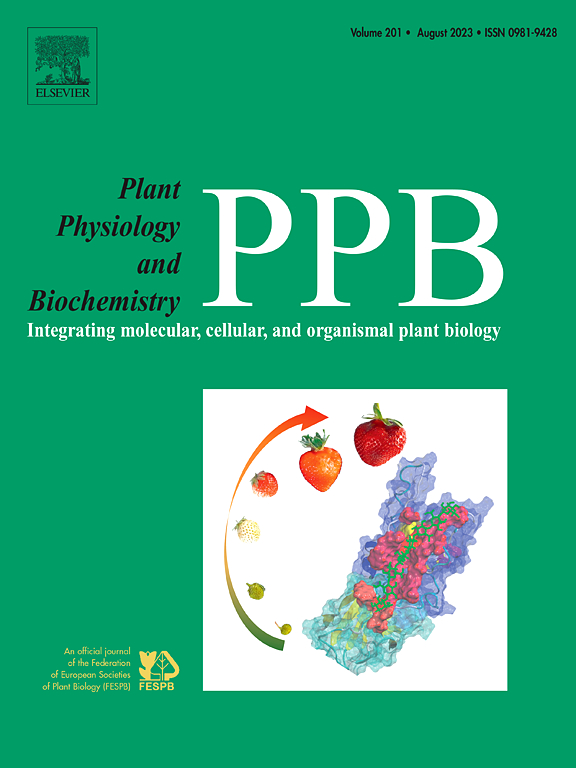杨树PdRabG3f通过促进内源脱落酸合成抑制根伸长和提高耐盐性
IF 5.7
2区 生物学
Q1 PLANT SCIENCES
引用次数: 0
摘要
小GTPases家族的蛋白质,特别是Rab蛋白,参与植物根系发育。特别是RabG亚家族蛋白,在调控植物的胁迫反应中发挥重要作用。本研究发现,杨树RabG蛋白PdRabG3f在根表皮、根毛和维管柱中具有组织特异性活性。功能表征进一步表明,过表达PdRabG3f显著抑制了转基因杨树的根伸长,减少了最大根长和鲜根重,而抑制PdRabG3f则促进了根的生长,这一表型与其空间表达模式一致。在PdRabG3f过表达系中,内源脱落酸(ABA)水平升高,这与外源ABA处理下ABA敏感性增强和进一步抑制根伸长有关。结果,这些品系在盐胁迫下表现出更好的恢复能力,包括更高的过氧化物酶活性,降低丙二醛含量,保持相对含水量。转录组分析进一步支持它们增强的耐盐性,揭示了应激反应基因的显著上调和应激反应途径的富集。这些发现证实了PdRabG3f通过ABA生物合成作为根生长的负调控因子,并强调了PdRabG3f通过ABA依赖的胁迫信号在提高根耐盐性方面的作用。本研究为木本植物中Rab蛋白介导的激素调控提供了新的见解,为提高杨树的抗逆性提供了潜在的靶点。本文章由计算机程序翻译,如有差异,请以英文原文为准。
Poplar PdRabG3f inhibits root elongation and increases salt tolerance by enhancing endogenous abscisic acid synthesis
Proteins belonging to the small GTPases family, particularly Rab proteins, are involved in plant root development. The RabG subfamily proteins, in particular, play a role in regulating plant stress responses. This study revealed that the poplar RabG protein PdRabG3f exhibited tissue-specific activity in root epidermis, root hairs, and vascular stele. Functional characterization further demonstrated that overexpression of PdRabG3f in transgenic poplar significantly inhibited root elongation, reducing maximum root length, and fresh root weight, whereas suppression of PdRabG3f enhanced root growth — a phenotype consistent with its spatial expression pattern. In PdRabG3f overexpression lines, elevated endogenous abscisic acid (ABA) levels were observed, which correlated with enhanced ABA sensitivity and further inhibition of root elongation under exogenous ABA treatment. As a result, these lines exhibited improved resilience under salt stress, including higher peroxidase activity, reduced malondialdehyde content, and maintained relative water content. Transcriptome analysis further supported their enhanced salt tolerance, revealing significant upregulation of stress-responsive genes and enrichment in stress response pathways. These findings establish PdRabG3f as a negative regulator of root growth via ABA biosynthesis and highlight its role in enhancing salt tolerance through ABA-dependent stress signaling. This study provides novel insights into Rab protein-mediated hormonal regulation in woody plants, offering potential targets for improving stress resilience in poplar.
求助全文
通过发布文献求助,成功后即可免费获取论文全文。
去求助
来源期刊
CiteScore
11.10
自引率
3.10%
发文量
410
审稿时长
33 days
期刊介绍:
Plant Physiology and Biochemistry publishes original theoretical, experimental and technical contributions in the various fields of plant physiology (biochemistry, physiology, structure, genetics, plant-microbe interactions, etc.) at diverse levels of integration (molecular, subcellular, cellular, organ, whole plant, environmental). Opinions expressed in the journal are the sole responsibility of the authors and publication does not imply the editors'' agreement.
Manuscripts describing molecular-genetic and/or gene expression data that are not integrated with biochemical analysis and/or actual measurements of plant physiological processes are not suitable for PPB. Also "Omics" studies (transcriptomics, proteomics, metabolomics, etc.) reporting descriptive analysis without an element of functional validation assays, will not be considered. Similarly, applied agronomic or phytochemical studies that generate no new, fundamental insights in plant physiological and/or biochemical processes are not suitable for publication in PPB.
Plant Physiology and Biochemistry publishes several types of articles: Reviews, Papers and Short Papers. Articles for Reviews are either invited by the editor or proposed by the authors for the editor''s prior agreement. Reviews should not exceed 40 typewritten pages and Short Papers no more than approximately 8 typewritten pages. The fundamental character of Plant Physiology and Biochemistry remains that of a journal for original results.

 求助内容:
求助内容: 应助结果提醒方式:
应助结果提醒方式:


